服务
文章信息
- 杨晓秋, 吴寅嵩, 闫金定, 宋海刚, 范建华, 李元广
- Yang Xiaoqiu, Wu Yinsong, Yan Jinding, Song Haigang, Fan Jianhua, Li Yuanguang
- 基于文献计量学的微藻生物技术发展趋势
- Trends of microalgal biotechnology: a view from bibliometrics
- 生物工程学报, 2012, 31(10): 1415-1436
- Chin J Biotech, 2012, 31(10): 1415-1436
- 10.13345/j.cjb.150311
-
文章历史
- Received: July 6, 2015
- Accepted: September 6, 2015
2. 华东理工大学 生物反应器工程国家重点实验室,上海 200237
2. State Key Laboratory of Bioreactor Engineering,East China University of Science and Technology,Shanghai 200237,China
微藻是一类介于微生物与高等植物细胞之间的单细胞生物,可以进行光合作用,能有效利用太阳能将水、CO2和无机盐转化为有机物[1]。微藻具有对光能的利用率高、生长速度快、对生长环境要求低及储能物质 (油脂、烃) 含量高等优点,被公认为最具发展潜力的第三代生物能源原料[2, 3]。此外,微藻的固碳效率是植物的10倍以上,可解决CO2的点源排放问题,是国内外生物固碳之首选[4, 5];微藻生长过程需要大量的N/P等营养,是净化富含N/P废水的有效途径[6, 7];除储能物质外,微藻还含有大量蛋白质、多糖、色素、多不饱和脂肪酸等生物活性成分,其应用面广、价值高[8]。微藻生长所需要的阳光取之不竭,所需碳源正是人类亟待大量固定的CO2,所需营养正是造成我国水体大面积富营养化的N/P,而利用微藻为原料加工而成的能源、水产饵料及饲料添加剂、营养补充剂及新资源食品等大健康产业产品的市场需求量极大。由此可见,微藻培养所用原料来源极其丰富且多为严重污染环境的“废物”,量大面广,而微藻产品的市场需求量也极其巨大,二者之间正好可以匹配,因此微藻生物技术这一战略性新兴产业可以被培育为一个应用面很广的“大产业”,其发展趋势非常值得探究[9]。
自然界中微藻的种类数以万计,形态各异,细胞生长迅速,并能够适应不同的光强、温度、湿度和营养生境,是人类尚未充分开发利用的重要生物资源。但是,迄今为止,仅有少数几种微藻 (如螺旋藻、小球藻、盐藻及雨生红球藻等) 实现产业化[10, 11, 12],而且整体产业规模仍然较小[13],全球微藻藻粉的年产量约为数万吨,远远没有发挥微藻资源的开发价值[14]。
微藻生物技术是以微藻生物学为基础,利用生物学和工程学原理,研究微藻藻种选育、细胞培养及其装备、采收及水的循环利用与处理、藻细胞的深加工及其应用等的生物技术。我国微藻生物学研究自20世纪50年代开始,近年来得到了迅猛的发展。本文首次对近9年来国内外已发表的有关微藻方面的论文及专利进行系统梳理与分析,藉此来探究微藻生物技术的发展趋势,为该领域的科技工作者的研究方向把握及相关政府部门的决策提供参考。
1 论文数据来源及分析本文以Web of Science 的SCI-Expanded 数据库为数据源进行检索,选择主题词为“microalgae”,时间跨度为2006年1月1日至2014年12月31日。
检索时间:2015年4月10日。检索微藻主题词的相关研究文献,共检索到7 588篇文献。主要从以下几个方面予以分析。
1.1 年度分布分析2006-2014年,微藻相关研究论文发表量总体呈现上升趋势,尤其是2011-2013年增长显著 (表1,图1),年增长率均超过25%。2014年微藻领域相关研究论文发表量较2013年增长了11%,截止至本文检索时间,数据库中2014年研究论文数据仍在持续更新,论文数量增长率仍有可能进一步提高。
| Years | 2006 | 2007 | 2008 | 2009 | 2010 | 2011 | 2012 | 2013 | 2014 |
| Quantity of published papers | 340 | 372 | 474 | 554 | 639 | 897 | 1 127 | 1 512 | 1 673 |
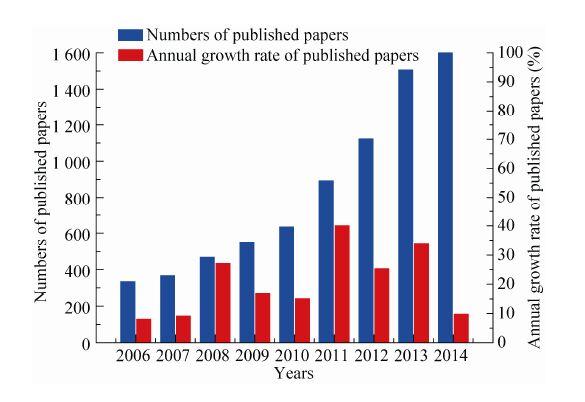
|
| 图1 SCI-Expanded 数据库检索到的以“microalgae”为主题词的论文数量及年增长率变化 Fig.1 The annual quantity and growth rate of published papers searched from SCI-Expanded database with the topic word “microalgae”. |
2006-2014年期间,共有超过100个国家或地区发表了有关微藻方面研究的论文,其中有24个国家或地区发文量超过100篇。美国发表了1 479篇论文,占总发文量的近20%,排名位居第一。紧随其后的依次是中国、西班牙、法国、澳大利亚。从论文的平均被引频次来看,发文量前十的国家中,德国最高,平均被引频次为16.17次,其次为美国和澳大利亚,平均被引频次超过15次。中国、韩国和日本的论文平均被引频次相对较低,说明我国微藻领域发表论文的质量还有待提高。2011年以来我国在微藻领域的发文量增长迅速,发文量仅次于美国,远远高于其他国家或地区 (图2),这与近年来中美等国家在微藻生物技术领域的大量投入是密不可分的。

|
| 图2 2006-2014 年主要国家或地区微藻领域论文发表情况 Fig.2 Annual quantity of published papers of main counties/regions in 2006-2014. |
表2,表3,表4分析发表论文的主要研究机构结果表明,发文量大于100篇的共有6个机构,由高到低依次是法国科学研究中心、中国科学院、法国发展研究所、美国加州大学、西班牙国家科学研究理事会和美国能源部。其中,法国科学研究中心发表论文数量最多,为316篇;美国能源部论文平均被引频次最高,为33.98。
| No. | Country/region | Published papers | Proportion in total published papers (%) | Total number of citations | Average number of citations | H-index |
| 1 | USA | 1 479 | 19.49 | 23 290 | 15.75 | 64 |
| 2 | China | 1 030 | 13.57 | 9 709 | 9.43 | 40 |
| 3 | Spain | 550 | 7.25 | 6 992 | 12.71 | 36 |
| 4 | France | 496 | 6.54 | 7 280 | 14.68 | 38 |
| 5 | Australian | 421 | 5.55 | 6 570 | 15.61 | 40 |
| 6 | Germany | 406 | 5.35 | 6 563 | 16.17 | 38 |
| 7 | South Korea | 370 | 4.88 | 2 850 | 7.70 | 25 |
| 8 | Indian | 321 | 4.23 | 3 757 | 11.70 | 31 |
| 9 | Japan | 303 | 3.99 | 2 098 | 6.92 | 22 |
| 10 | Italy | 294 | 3.88 | 4 268 | 14.52 | 28 |
| 11 | Brazil | 277 | 3.65 | 2 176 | 7.86 | 24 |
| 12 | UK | 272 | 3.59 | 4 241 | 15.59 | 30 |
| 13 | Canada | 258 | 3.40 | 3 166 | 12.27 | 27 |
| 14 | Portugal | 240 | 3.16 | 4 144 | 17.14 | 26 |
| 15 | Netherlands | 207 | 2.73 | 3 384 | 16.35 | 30 |
| 16 | Mexico | 189 | 2.49 | 1 644 | 8.70 | 22 |
| 17 | Taiwan, China | 188 | 2.48 | 2 895 | 15.40 | 27 |
| 18 | Belgium | 148 | 1.95 | 1 960 | 13.24 | 24 |
| 19 | Malaysia | 133 | 1.75 | 1 523 | 11.45 | 21 |
| 20 | Turkey | 128 | 1.69 | 2 097 | 16.38 | 24 |
| No. | Research institution | Quantity of published papers | Total number of citations | Average number of citations | H-index |
| 1 | Centre National de la Recherche Scientifique | 316 | 3 890 | 12.31 | 31 |
| 2 | Chinese Academy of Sciences | 301 | 2 783 | 9.25 | 22 |
| 3 | Institut De Recherche Pour Le Developpement (Ird) | 141 | 1 408 | 9.99 | 18 |
| 4 | University of California System | 139 | 2 420 | 17.41 | 24 |
| 5 | Consejo Superior de Investigaciones Cientificas (CSIC) | 122 | 2 307 | 18.91 | 25 |
| 6 | United States Department of Energy (DOE) | 109 | 3 704 | 33.98 | 26 |
| 7 | Ifremer | 98 | 1 074 | 10.96 | 17 |
| 8 | Wageningen University Research Center | 95 | 1 590 | 16.74 | 21 |
| 9 | Russian Academy of Sciences | 91 | 575 | 6.32 | 13 |
| 10 | University of Nantes Angers Le Mans | 83 | 776 | 9.35 | 15 |
| No. | Research institution | Quantity of published papers | Total number of citations | Average number of citations | H-index |
| 1 | Chinese Academy of Sciences | 301 | 2 783 | 9.25 | 22 |
| 2 | Ocean University of China | 71 | 357 | 5.03 | 12 |
| 3 | University of Chinese academy of sciences | 67 | 302 | 4.51 | 10 |
| 4 | Zhejiang University | 49 | 476 | 9.71 | 10 |
| 5 | Tsinghua University | 46 | 917 | 19.93 | 17 |
| 6 | Jinan University | 43 | 198 | 4.60 | 7 |
| 7 | South China University of Technology | 37 | 677 | 18.30 | 14 |
| 8 | Xiamen University | 34 | 234 | 6.88 | 10 |
| 9 | University of Hong Kong | 27 | 677 | 25.07 | 13 |
| 10 | Chinese Academy of Fishery Sciences | 23 | 79 | 3.43 | 5 |
中国科学院发表论文301篇,仅次于法国科学研究中心,位居第二。中国科学院包括的研究单位较多,主要有青岛生物能源与过程研究所、海洋研究所、大连化学物理研究所、武汉水生生物研究所、广州能源研究所等多个机构,但论文的平均被引频次和H-指数在前6位机构中均最低。
国内机构中,在微藻领域发文量较多的有中国科学院 (含中国科学院大学)、中国海洋大学、浙江大学、清华大学、暨南大学和香港大学等。其中,文章平均引用频次最高的是香港大学。
1.4 主要研究方向2006-2014年微藻领域相关论文的研究方向主要集中在生物技术和应用微生物学 (Biotechnology & Applied Microbiology)、水生生物学 (Marine & Freshwater Biology)、能源与燃料 (Energy & Fuels)环境科学与生态学 (Environmental Science & Ecology) 以及农学 (Agriculture) 等 (表5)。
| No. | Main research direction | Numbers of published papers | Proportion in total published papers (%) |
| 1 | Biotechnology & Applied Microbiology | 2 378 | 31.34 |
| 2 | Marine & Freshwater Biology | 1 585 | 20.89 |
| 3 | Energy & Fuels | 1 484 | 19.56 |
| 4 | Environmental Science & Ecology | 1 295 | 17.07 |
| 5 | Agriculture | 1 048 | 13.81 |
| 6 | Engineering | 1 000 | 13.18 |
| 7 | Chemistry | 745 | 9.82 |
| 8 | Plant Sciences | 503 | 6.63 |
| 9 | Biochemistry & Molecular Biology | 450 | 5.93 |
| 10 | Oceanography | 411 | 5.416 |
分析2006-2014年微藻生物技术领域各研究方向每年论文发表情况,发现生物技术和应用微生物学、能源与燃料、环境科学与生态学以及农学4个研究方向增长十分明显 (图3)。尤其是能源与燃料研究方向,2006年仅发表6篇论文,到2014年则增长到452篇,这也说明了近年来微藻能源的开发已逐渐成为全球的研究热点。

|
| 图3 2006−2014 年微藻领域主要研究方向发表论文的时间分布 Fig.3 Distribution of microalgae research papers in time in 2006−2014. |
| No. | Title of research papers | References | Journal name | Year | Total number of citations | Annual citations on average |
| 1 | Microalgae for oil: strain selection, induction of lipid synthesis and outdoor mass cultivation in a low-cost photobioreactor | [31] | Biotechnology and Bioengineering | 2009 | 631 | 90.14 |
| 2 | Second generation biofuels: high-efficiency microalgae for biodiesel production | [32] | Bioenergy Research | 2008 | 536 | 67 |
| 3 | Life-cycle assessment of biodiesel production from microalgae | [33] | Environmental Science & Technology | 2009 | 373 | 53.29 |
| 4 | Microalgae as a raw material for biofuels production | [34] | Journal of Industrial Microbiology & Biotechnology | 2009 | 339 | 48.43 |
| 5 | Lipid productivity as a key characteristic for choosing algal species for biodiesel production | [35] | Journal of Applied Phycology | 2009 | 323 | 46.14 |
| 6 | Environmental life cycle comparison of algae to other bioenergy feedstocks | [36] | Environmental Science & Technology | 2010 | 296 | 49.3 |
| 7 | Toxicity of nanoparticles of CuO, ZnO and TiO2 to microalgae Pseudokirchneriella subcapitata | [37] | Science of the Total Environment | 2009 | 293 | 41.86 |
| 8 | Biofuels from microalgae | [38] | Biotechnology Progress | 2008 | 277 | 34.62 |
| 9 | Effects of nitrogen sources on cell growth and lipid | [39] | Applied Microbiology and Biotechnology | 2008 | 274 | 34.25 |
| 10 | Effect of temperature and nitrogen concentration on the growth and lipid content of Nannochloropsis oculata and Chlorella vulgaris for biodiesel production | [40] | Chemical Engineering and Processing | 2009 | 231 | 33.00 |
| 11 | Biodiesel production by microalgal biotechnology | [41] | Applied Energy | 2010 | 230 | 38.33 |
| 12 | Effect of iron on growth and lipid accumulation in Chlorella | [42] | Bioresource Technology | 2008 | 229 | 28.62 |
| 13 | A high throughput Nile red method for quantitative measurement of neutral lipids in microalgae | [43] | Microbiological Methods | 2009 | 220 | 31.43 |
| 14 | Biosorption of lead from aqueous solutions by green algae Spirogyra species: Kinetics and equilibrium studies | [44] | Journal of Hazardous Materials | 2008 | 217 | 27.12 |
| 15 | The potential of sustainable algal biofuel production using wastewater resource | [45] | Bioresource Technology | 2011 | 215 | 43.00 |
| 16 | Biomass and lipid productivities of Chlorella vulgaris under autotrophic, heterotrophic and mixotrophic growth conditions | [46] | Biotechnology Letters | 2009 | 196 | 28.00 |
| 17 | Comparison of several methods for effective lipid extraction from microalgae | [47] | Bioresource Technology | 2010 | 194 | 32.33 |
| 18 | Lipid accumulation and CO(2) utilization of Nannochloropsis oculata in response to CO(2) aeration | [48] | Bioresource Technology | 2009 | 188 | 28.86 |
| 19 | Micro and macroalgal biomass: A renewable source for bioethanol | [49] | Bioresource Technology | 2011 | 182 | 36.40 |
| 20 | The promise and challenges of microalgal-derived biofuels | [50] | Biofuels Bioproducts & Biorefining-biofpr | 2009 | 181 | 25.86 |
通过对2006−2014年微藻领域相关论文的研究发现,论文总引用次数超过200次的有15篇,其中Rodolfi等2009年在Biotechnology and Bioengineering上发表的论文“Microalgae for oil: strain selection,induction of lipid synthesis and outdoor mass cultivation in a low-cost photobioreactor”[31]的引用总次数及年平均引用次数均最高 (表6)。在引用次数前20篇的研究论文中,有18篇论文与微藻能源相关,研究内容包括高产油藻种的筛选、微藻培养、油脂提取、全生命周期分析及油脂代谢调控等 (表6)。由此可见,微藻能源是近年来微藻生物技术领域中的研究热点。
2 专利数据来源及其分析德温特创新索引 (Derwent innovations index,缩写为DII) 是世界上最全面的国际专利信息数据库,收录来自全球40 多个专利机构(涵盖100 多个国家) 的1 000 多万条基本发明专利。采用德温特创新索引数据库,以“microalgae”为主题词进行检索,检索时间段为2006-2014年。
检索时间2015年4月10日,共检索到 1 729个专利族。其中,有2 989条专利公开年为2006-2014年。
2.1 专利公开年分布从专利的公开年份数据来看,近年来微藻领域相关专利数量增长较快 (图4)。考虑到专利公开有一定的滞后,2014年微藻相关专利数量仍会有大幅增加。

|
| 图4 2006−2014 年微藻生物技术相关专利公开年分布 Fig.4 Distribution of microalgae biotechnology patents in year in 2006−2014. |
分析2006-2014年微藻领域相关专利的优先权国家或地区分布 (图5),中国专利数量最多为1 093项,紧随其后的是韩国 (468项)、美国 (445项)。仅中美韩三国的专利就占总专利数的67%,说明微藻生物技术的开发和知识产权保护在这3个国家较为重视。
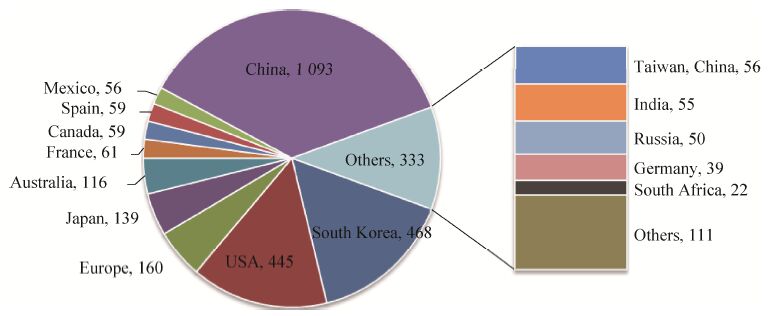
|
| 图5 2006−2014 年微藻生物技术相关专利优先权国家及地区分布 Fig.5 Distribution of patents in countries or regions in 2006−2014. |
2009年以来,我国微藻领域相关专利增长迅速,远远超过其他国家 (图6),表明近年来微藻相关产品及技术开发在我国企业界和学术界受到重视,预计未来会有很广阔的市场开发前景。

|
| 图6 2006−2014 年主要国家微藻相关专利公开年分布 Fig.6 Distribution of patents of main countries or regions in 2006−2014. |
2006-2014年微藻领域相关专利的德温特手工代码主要集中在B04-F08A (藻类)、D05-A03 (发酵装置)、D05-H08 (细胞及组织培养) 和D05-H02 (培养装置) (表7),这些专利主要涵盖藻种、培养工艺及生物反应器相关技术,说明开发高效的培养工艺和生物反应器装置所涉及的相关技术均是目前微藻领域的研究热点。
| Derwent manual code | Fields of technology | Quantity of patent family | Proportion in total patent families (%) |
| B04-F08A | Algae | 523 | 30.51 |
| D05-A03 | Fermentation apparatus [general] | 414 | 24.15 |
| D05-H08 | Cell or tissue culture | 384 | 22.40 |
| D05-H02 | Culture apparatus | 253 | 14.76 |
| A12-W11L | (Immobilised) enzymes or microorganisms, microbiology (polymer use) | 199 | 11.61 |
| D05-C | Chemicals by fermentation (biosynthesis) [others; general.] | 175 | 10.21 |
| B11-C06 | Containers, packing, preserving apparatus, storage tanks, transporting apparatus [general] | 160 | 9.34 |
| B11-A04 | Fermentation apparatus | 157 | 9.16 |
对近年来藻类生物技术研究领域涉及的主要微藻种类进行检索,在检索的7种微藻种类中,与小球藻Chlorella相关的论文数量最多,达1 805篇,远高于其他藻类 (表8)。同时,与Chlorella相关研究论文数量呈逐年增加 (图7),研究方向主要集中在生物技术和应用微生物学 (Biotechnology & Applied Microbiology)、能源与燃料 (Energy & Fuels)、农业 (Agriculture)、工程学 (Engineering) 以及环境科学与生态学 (Environmental Science & Ecology) 等几个方向。2006−2014年衣藻Chlamydomonas、微拟球藻Nannochloropsis、三角褐指藻Phaeodactylum和雨生红球藻Haematococcus相关研究论文数量均呈逐年上升趋势,但螺旋藻Spirulina和杜氏藻Dunaliella相关研究论文的发表数量在2014年有所下降。由此可见,Chlorella是目前微藻生物技术研究中最为广泛的微藻种类。
| No. | Topic words | Quantity of published papers | Total number of citations | Average number of citations | H-index |
| 1 | Microalgae & Chlorella | 1 805 | 22 432 | 12.43 | 65 |
| 2 | Microalgae & Chlamydomonas | 792 | 11 607 | 14.66 | 54 |
| 3 | Microalgae & Nannochloropsis | 557 | 7 350 | 13.20 | 37 |
| 4 | Microalgae & Dunaliella | 416 | 5 829 | 14.01 | 37 |
| 5 | Microalgae & Spirulina | 495 | 7 780 | 15.89 | 41 |
| 6 | Microalgae & Phaeodactylum | 383 | 6 605 | 17.25 | 33 |
| 7 | Microalgae & Haematococcus | 220 | 3 090 | 14.05 | 27 |

|
| 图7 2006−2014 年小球藻相关研究论文发表的时间分布 Fig.7 Distribution of published Chlorella research papers in 2006−2014. |
在2006-2014年微藻生物技术领域相关专利中,对7种主要微藻种类进行检索 (表9) ,结果显示小球藻Chlorella相关专利数量最多,其次是螺旋藻Spirulina和杜氏藻Dunaliella,这3种藻均是目前已经实现大规模产业化的主要藻种。有174个专利族,包括358项公开专利与小球藻Chlorella相关,远高于其他藻种,说明小球藻Chlorella是目前微藻生物技术研发及产业化中涉及最多的藻种,这与研究论文分析的结果相一致。
| No. | Microalgae species | Topic keywords | Numbers of patent families | Numbers of patents |
| 1 | Chlorella | Microalgae & Chlorella | 174 | 358 |
| 2 | Spirulina | Microalgae & Spirulina | 67 | 161 |
| 3 | Dunaliella | Microalgae & Dunaliella | 56 | 130 |
| 4 | Nannochloropsis | Microalgae & Nannochloropsis | 52 | 85 |
| 5 | Chlamydomonas | Microalgae & Chlamydomonas | 49 | 96 |
| 6 | Haematococcus | Microalgae & Haematococcus | 41 | 96 |
| 7 | Phaeodactylum | Microalgae & Phaeodactylum | 27 | 44 |
对SCI-Expanded 数据库中近年来藻类领域涉及的主要技术进行了检索,包括藻种选育、培养技术、光生物反应器、采收技术、加工技术及分子生物学技术等6个方面。其中微藻培养技术相关研究论文数量最多,达3 063篇,其次是藻种 (藻株) 选育和微藻加工技术 (包括能源、食品、饲料加工技术等),分别为2 552篇和1 159篇。论文数量较少的依次是微藻采收技术、微藻分子生物学技术及光生物反应器3个研究方向 (表10),论文数量分别为521篇、616篇和781篇。不同技术研究情况仍存在一些差距,这与各技术所在领域的发展现状和研究难度密切相关。
| Research direction | Topic words | Quantity of published papers | Total number of citations | Average number of citations | H-index |
| Microalgae strain selection | Microalgae and strains or species | 2 552 | 28 507 | 11.17 | 59 |
| Microalgae cultivation | Microalgae and culture or cultivation or phototrophic or heterotrophic or mixtrophic | 3 063 | 34 407 | 11.23 | 69 |
| Microalgae collection | Microalgae and harvest | 521 | 7 229 | 13.88 | 39 |
| Photobioreactor | Microalgae and bioreactor or photobioreactor | 781 | 11 323 | 14.50 | 46 |
| Microalgae processing | Microalgae and biodiesel processing or bioenergy processing feed processing or food processing or oil extraction or extraction | 1 159 | 17 922 | 15.46 | 57 |
| Molecular biological technology | Microalgae and gene or genetic or molecular biology or transgenosis | 616 | 6 719 | 10.91 | 38 |
比较6个主要技术方向研究论文逐年的发表情况,增长最快的为微藻采收技术,由2006年的5篇,增长到2014年的159篇。此外,增长较快的还有光生物反应器及微藻加工技术相关研究论文,这些技术早期研究较少,研究基础较差,随着近年来微藻能源和微藻固碳等战略性新兴产业的发展才逐渐引起人们的重视,进而成为全球的研究热点 (图8)。
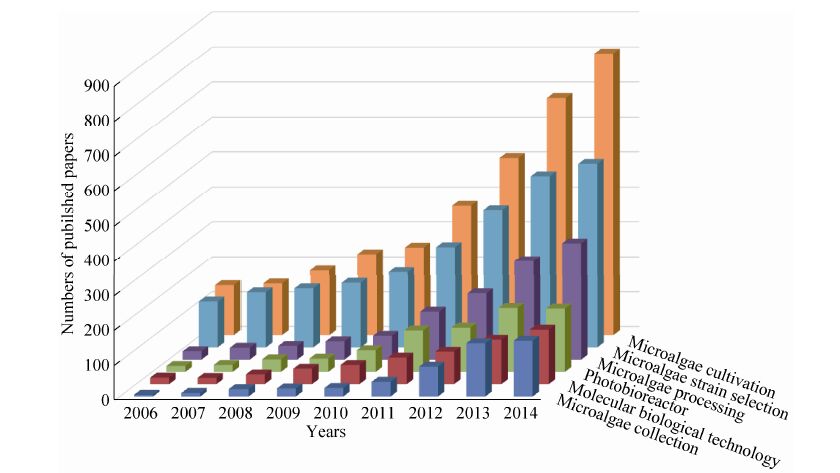
|
| 图8 2006−2014 年每年主要微藻技术方向研究论文发表情况 Fig.8 Annual quantity of published papers of main research directions in 2006−2014. |
中美目前是微藻生物技术研究最主要的两个国家,比较两国在6个主要技术研究方向的论文发表情况,我国在微藻采收及加工技术上的研究与美国差距较大,发文量不及美国的50%。但是我国在微藻培养方面的研究发文量已与美国接近,这与我国微藻养殖行业发展较早、产品已广泛用于食品及水产养殖等行业、微藻产业规模较大、微藻培养技术研究较早等因素有关。
对德温特创新索引中6个主要技术方向相关的专利进行检索,发现与微藻培养技术相关的专利最多,共检索到985个专利族,远高于其他技术。其次是光生物反应器,有336个专利族 (图9)。微藻高效培养工艺及光生物反应器是微藻培养的核心技术,是微藻生物技术产业化过程中最关键的环节。
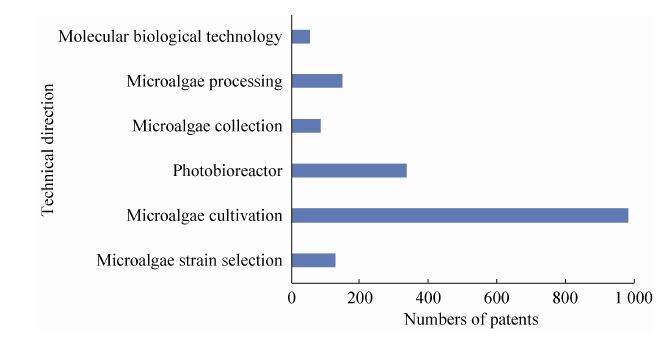
|
| 图9 2006−2014 年主要微藻技术方向的专利分布 Fig.9 Distribution of patents in main microalgae technical direction in 2006−2014. |
近年来由于全球能源及环境问题的日益严重,微藻能源、微藻固碳及废水处理成为了微藻生物技术领域主要的研究热点[15, 16]。对SCI-Expanded 数据库中近年来微藻能源、微藻固碳及污水处理相关的文献进行了检索 (表11),其发表量逐年递增,其中,微藻能源发展最快 (图10)。
| Research direction | Topic words |
| Microalgae energy | Microalgae and triacylglycerol or fuel or bioenergy or biofuel or biohydrogen or biodiesel or bioethanol or biohydrocarbon |
| Microalgae CO2 fixation | Microalgae and flue gas or carbon or CO2 or carbon dioxide and sequestration or consolidation or fixation or conversion |
| Microalgae wastewater treatment | Microalgae and sewage or waste water or wastewater or waste or runoff or effluent and treat or treatment or disposal or purification |
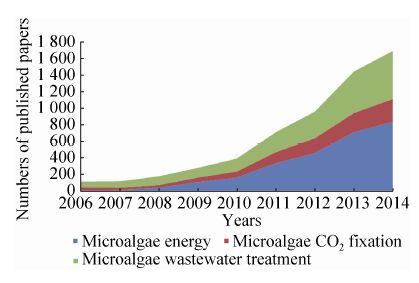
|
| 图10 2006−2014 年微藻能源、微藻固碳及废水处理研究相关论文发表的时间分布 Fig.10 Distribution of microalgae energy,microalgae CO2 fixation and microalgae wastewater treatment research papers in 2006−2014. |
从发文量看,中美在微藻能源、固碳及污水处理3个研究方向较其他国家和地区均处于领先地位。但无论是发文量还是论文的影响力我国与美国仍存在一定的差距 (表12),其中最突出的是微藻固碳研究方向,发文量仅为美国的59.82%,论文平均引用频率仅为美国的39.71%。
| Research direction | Countries | Numbers of published papers | Proportion in total published paper (%) | Total number of citations | Average number of citations | H-index |
| Microalgae energy | USA | 739 | 27.90 | 15 010 | 20.31 | 60 |
| China | 438 | 16.54 | 6 024 | 13.75 | 36 | |
| Microalgae CO2 fixation | USA | 219 | 20.99 | 4 704 | 21.48 | 34 |
| China | 131 | 12.50 | 1 118 | 8.53 | 16 | |
| Microalgae wastewater treatment | USA | 414 | 19.08 | 7 042 | 17.01 | 40 |
| China | 324 | 14.93 | 3 388 | 10.46 | 28 |
目前,中国科学院在微藻能源、固碳及污水处理3个方向研究论文的发表量均高于国内外其他研究机构,但文章的平均引用频次及H-指数与国际上其他研究机构还有差距 (表13)。微藻能源方面,发文量前五位的机构中,美国能源部发表的研究论文平均引用频次最高,得益于美国能源部在微藻能源研究方面的重视和
| Research direction | No. | Research institution | Quantity of published papers | Total number of citations | Average number of citations | H-index |
| Microalgae energy | 1 | Chinese Academy of Sciences | 134 | 1 885 | 14.07 | 19 |
| 2 | United States Department of Energy DOE | 82 | 3 428 | 41.80 | 24 | |
| 3 | University of California System | 80 | 1 615 | 20.19 | 19 | |
| 4 | Korea Advanced Institute of Science Technology KAIST | 51 | 309 | 6.06 | 10 | |
| 5 | National Cheng Kung University | 50 | 1 098 | 21.96 | 15 | |
| Microalgae CO2 fixation | 1 | Chinese Academy of Sciences | 38 | 340 | 8.95 | 9 |
| 2 | National Cheng Kung University | 32 | 670 | 20.94 | 15 | |
| 3 | Centre National de la Recherche Scientifique CNRS | 25 | 428 | 17.12 | 10 | |
| 4 | Consejo Superior de Investigaciones Cientificas CSIC | 22 | 820 | 37.27 | 14 | |
| 5 | University of California System | 21 | 772 | 36.76 | 12 | |
| Microalgae wastewater treatment | 1 | Chinese Academy of Sciences | 81 | 720 | 8.89 | 12 |
| 2 | Centre National de la Recherche Scientifique CNRS | 52 | 412 | 7.92 | 11 | |
| 3 | University of Minnesota | 33 | 841 | 25.48 | 14 | |
| 4 | University of California System | 30 | 228 | 7.60 | 8 | |
| 5 | Consejo Superior de Investigaciones Cientificas CSIC | 27 | 436 | 16.15 | 10 |
支持,以及美国国内很多研究机构的参与。微藻固碳方面,西班牙国家科学研究理事会所发表研究论文的平均引用频次最高,达37.27;其次是美国加州大学,平均引用频次为36.76。微藻污水处理方面,美国明尼苏达州大学所发表论文的质量较高,平均引用频次25.48。
对德温特创新索引中微藻能源、微藻固碳及污水处理相关的专利进行检索,发现近年来3个领域的专利公开数均有较大增长 (图11)。中美两国是主要的专利授权国,在微藻固碳及微藻污水处理领域,我国已成为最大的专利国,均占相关技术研究领域专利总数的37%左右 (图12)。
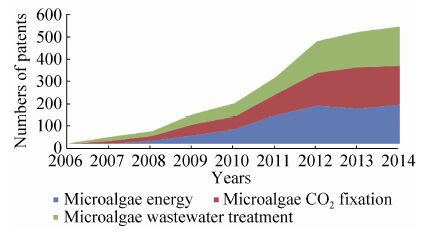
|
| 图11 2006−2014 年微藻能源、微藻固碳及废水处理技术相关专利公开的时间分布 Fig.11 Distribution of microalgae energy,microalgae CO2 fixation and microalgae wastewater treatment technology patents in 2006−2014. |

|
| 图12 2006−2014 年微藻能源、微藻固碳及污水处理相关专利优先权国家及地区分布 Fig.12 Distribution of microalgae energy,microalgae CO2 fixation and microalgae wastewater treatment technology patents in countries or regions. |
通过对2006−2014年微藻生物技术研究论文和专利数量的统计和分析,可以看出,当前微藻生物技术已步入快速发展阶段,除了把微藻开发成传统意义上的新食品原料、功能食品外,随着新能源、碳减排和环保等方面的迫切需要,微藻在生物能源、生物固碳、富含N/P废水、动物饲料及食品等行业具有广阔的应用前景[17]。尤其是在生物能源与固碳减排方面,微藻具有无可比拟的独特优势[18, 19]。与其他能源特别是生物质能源相比,微藻能源的生物质来源不具有既得性 (其他能源的原料可由其他领域提供,如纤维素乙醇的原料由农业部门提供[20]),微藻能源加工所用的原料——能源微藻细胞必须自行利用阳光、碳源及N/P等培养而获得;此外,能源微藻是从悬浮于低密度大体积的水相状态中采收而获得且水含量很高[21],这与能源作物及其他能源原料完全不同。再者,利用高效的光合作用所获得的微藻,其细胞的化学组分非常复杂 (大规模光自养培养的微藻细胞中油脂或烃类含量一般不超过40%,其余为蛋白质、多糖及色素等生物活性物质),这既为人类提供了多种营养物质和储能物质,也对从微藻细胞中同时分离提取营养物质和储能物质的技术提出了挑战,因此微藻能源的生产过程,必然伴随着大量基于营养及生物活性的生物制品的生产,这两类产品的耦合是国内外微藻生物技术产业化发展的“必经之路”[22, 23]。
当前国际微藻生物技术产业化发展势头迅猛,以微藻能源 (固碳) 为例,多数微藻能源公司和研究机构纷纷转向开发耦合“微藻能源、碳减排、废水资源化利用、高附加值产品开发”的一体化技术,在追求“高产”的同时均采用了“多联产”策略以缓解“成本”压力,并大力推进成果转化,开展工程示范。
随着碳减排的迫切需要,微藻固碳技术将得到各界的纷纷关注。例如美国政府将发布由美国环境保护署拟定的“清洁能源计划”[24],阐明了针对美国发电厂的环保条例及法规,限制美国发电厂的碳排放量,并要求到2030年美国所有发电厂的碳排放量减少30%,相当于该国每年超过一半家庭的碳排放量,这一法规的出台,无疑将推动微藻固碳技术的发展和应用。此外,2015年7月,美国能源部又资助了6项关于微藻能源方面的项目,总资助金额高达 1 800万美元,项目将围绕微藻高附加值产品、微藻固碳以及敌害生物防治等方面展开重点研究,预期在2019年把微藻生物燃料的成本降低到5美元/加仑[25]。
随着实现低碳经济和节能减排的迫切需要,相信制约微藻能源 (固碳) 产业化的高成本这一瓶颈问题必将逐步得以解决。短期内的成本问题可以通过以下几个方面的集成来平衡:1) 持续的技术研发提高效率;2) CO2废气、富含N/P废水等废物资源化以节省原辅材料消耗成本;3) 非油脂组分的低成本综合利用 (需建立严格的质量标准体系,研究开发相应的后处理技术,避免废物资源化利用后对藻体综合利用所引起的负面效应)。按照上述思路,在适合于能源微藻终年培养且具有CO2资源及廉价的N/P资源的我国部分地区 (如我国云南等地),微藻能源及微藻固碳有望在2020年前后实现小规模产业化。
前文对文献与微藻生物技术发展趋势进行了分析,下面两部分将对我国的情况进行简单介绍与展望。
5 我国目前微藻生物技术的科技布局、重要成果及发展瓶颈多年来,在预见到微藻能源在未来国民经济和科技实力竞争中的地位后,科技部和有关部门先后启动了一系列相关研究计划,为该研究领域关键技术的突破奠定了很好的基础。如科技部的“十五”863计划项目“富含EPA、DHA等营养物质的海洋微藻开发技术” (819-02-01)、重大基础研究前期研究专项“微绿球藻Nannochloropsis sp. EPA生成途径与酶系表达生态调控研究”(2005-2007),“十一五”863计划项目 (2007AA09Z400)“海洋微藻合成PUFA关键酶基因研究技术”、“产能海洋微藻的分离筛选和高效培养”(2008-2010)、重点项目“CO2-油藻-生物柴油关键技术研究”(2009年批准)、“十一五”科技支撑项目课题 (2006BAD09A12)“海洋微藻高效培养工程化技术集成与示范”(2006−2010) 等;中国科学院2008年启动的“太阳能计划”、中国-俄罗斯科学院国际合作项目“海洋产能微生物采集与筛选”(2008−2009) 等。
“十二五”期间,我国政府对微藻能源和微藻固碳及废物资源化利用等方面给予了高度重视。科技部在973计划、863计划和科技支撑计划中从不同角度对微藻能源和微藻固碳及废物资源化利用予以大力支持,资助总额为1.600 7亿元人民币,具体见表14。此外,中国石化、国家海洋局、山西省、广东省、上海市等也对微藻能源和微藻固碳等给予了大力支持。
| 项目类别 | 立项部门 | 资助额度(万元) | 起止年限 | 项目 (课题) 名称 | 项目 (课题) 负责人 |
| 973计划能源领域 | 基础司 | 2805 | 2011-2015 | 微藻能源规模化制备的科学基础 | 李元广 |
| 国家科技支撑计划 | 农村司 | 4300 | 2012-2015 | 能源微藻育种与高效生产关键技术研究与示范 | 吴庆余 |
| 863计划能源领域(固碳) | 高新司 | 998 | 2012-2015 | “燃煤烟气CCUS关键技术”中的课题“CO2生物转化应用技术” | 程军 |
| 973计划 | 基础司 | 444 | 2012-2016 | “高效绿色炼油技术的化学和工程基础”中的课题“微藻用于炼油过程NOx减排的工程基础” | 荣峻峰 |
| 863计划能源领域 | 高新司 | 2690 | 2012-2016 | 新型能源藻培养与能源产品转化技术 | 胥维昌 |
| 863计划资环领域 | 社发司 | 2321 | 2013-2016 | 利用微藻清洁制备生物燃料关键技术 | 张成武 |
| 863计划生物医药领域 (固碳) | 社发司 | 2449 | 2014-2016 | 微藻生物固碳关键技术与产品开发 | 宋立荣 |
我国在微藻生物技术领域如种质资源和大规模培养技术等方面具有较好的研究工作基础,且微藻产业初具规模,如螺旋藻Spirulina产量居世界第一[16]。近年来,我国发展微藻生物技术的最大推动力来自于保障国家能源和资源战略安全的迫切需求,即在微藻能源 (固碳) 方面予以了大量关注。面向全世界掀起的微藻能源及微藻固碳开发热潮,为了提升相关技术的原始创新能力,我国许多大学和研究机构开展了大量研究工作,在微藻优良藻种的选育 (如中国科学院水生生物学研究所、中国海洋大学、中国科学院海洋所、暨南大学、厦门大学等)、代谢调控与基因工程 (如中国科学院青岛能源所、清华大学、中国科学院遗传与发育生物学研究所、中国科学院水生生物学研究所、华南理工大学、中国科学院海洋研究所、中国科学院烟台海岸带研究所、北京大学、华东理工大学等)、微藻规模培养 (如华东理工大学、中国科学院过程工程研究所、新奥集团、中国科学院广州能源所、中国科学院海洋研究所、中国科学院青岛能源所、中国科学院大连化学物理研究所、浙江大学等)、高效光生物反应器研制 (如华东理工大学、中国科学院过程工程研究所、中国科学院青岛能源所等)、藻体高效采收 (如中国科学院过程工程研究所、中国科学院天津工业生物技术研究所等)、油脂提取与生物柴油制备 (如北京化工大学、中国科学院广州能源所、上海交通大学等)、藻体其他成分综合利用 (如南京工业大学、中国石油大学 (北京) 等) 等方面,已取得许多可喜结果,例如我国在微藻培养领域开发了“异养-稀释-光诱导”串联培养[26]、异养细胞作为种子的光自养培养[27]等新模式,在光生物反应器研制方面获得敏感性参数可用于指导光生物反应器的优化等[28, 29, 30]。把握时机,加大发展力度,我国在该领域将有望很快赶超国际先进水平。
众所周知,微藻大规模开发利用的首要问题是要解决微藻规模化培养问题。结合国内外微藻生物技术发展现状及我国国情,当前微藻生物技术产业化在技术层面主要在以下几个方面需要集中攻克:1) 光生物反应器及微藻培养工艺的优化与放大;2) 微藻高效光合固碳和生长代谢网络的认识与改造;3) 碳源选择、CO2的高效吸收及其与微藻光自养培养过程的耦合;4) 微藻养殖用水的循环利用及处理;5) 微藻光自养培养过程敌害生物的有效防治;6) 微藻生产系统的原料、过程、产物检测方法与标准;7) 微藻采收,色素、蛋白、油脂等有效成分提取及产品加工与应用;8) 集“微藻能源、微藻固碳、高附加值产品”一体化技术的集成、优化与示范。
其中如何开发高效低成本的大规模培养技术及系统、建立适合于我国国情的微藻产业统一的技术标准体系等,则是当前促进我国微藻生物技术产业快速发展中亟待解决的瓶颈问题之一。
6 相关发展建议在大众创业、万众创新,科技驱动型发展的背景下,缓解能源短缺压力、发展低碳经济、实现新型循环经济,保护环境与改善生态、解决“三农”问题、建设节约型社会,都呼唤微藻生物技术这一战略性新兴产业的快速发展。系统的基础研究和技术优化集成方面的研究不足,导致了成本高、效率低,从而制约了我国微藻生物技术产业的发展。
6.1 技术研发层面藻种方面:继续开展新的藻种资源,特别是具工业应用性状、高附加值产品联产性状的特色藻种的发掘及筛选;加大现代生物技术进行微藻藻种的改良与构建,推动可工业化应用的新型燃料分子合成与固碳的基因工程藻株的构建。
生物质规模化获得方面:建立低成本、高密度、低能耗、低水耗的微藻创新培养方法;发展低成本、易放大、少维护和高光效的微藻培养装备技术;建立基于富含N/P废水、CO2废气等资源化利用的微藻培养技术体系,建立连续或半连续的高效培养工艺;解决户外大规模培养过程中的敌害生物防治问题。
产业技术模式方面:突出微藻高值化产品耦联及与碳减排耦联的微藻能源生产技术模式的创立与示范;加强微藻生物炼制技术的研发,以大幅降低微藻生物能源的综合成本,促进微藻能源 (固碳) 产业的形成。
6.2 政策方面“十二五”期间科技部在微藻能源与微藻固碳方面相继布置了包括973、支撑计划及多个863项目,但项目支持较分散且部分关键技术的研究内容重叠,不利于真正实现重大创新、关键突破与系统集成,建议在“十三五”期间能够集中优势单位、通过链条式分解,以微藻生物技术专项形式予以重点支持。其立题的指导思想应该调整为“市场、质量、成本”,围绕此开展技术集成、关键技术研发及相关重大基础研究。
由于目前微藻能源和微藻固碳的商业化应用的经济性尚无市场竞争力,因此应加强支持以关键单元技术突破与单元技术中试放大为核心的研究,加快推进微藻能源与微藻固碳研究平台的构建、系统集成优化与产业化示范。
鼓励与支持微藻能源与微藻固碳及废物资源化利用产业化技术的开发和现有微藻生物技术产业相结合;着重微藻高值化产品生产技术的研发、中试与产业化应用,为微藻能源与微藻固碳及富含氮/磷资源有效利用的战略性新兴产业的形成奠定技术和工程方面的基础。
加强“官产学研用”紧密结合,大力推动具备产业化条件的地方政府、企业及国际合作,同时要大力支持微藻生物技术方面的人才培养,特别是工程方面人才亟待培养;尽快成立中国微藻产业联盟与国家级微藻生物技术工程研究中心及微藻生物技术国家重点实验室,聚集我国微藻生物技术领域的核心力量,突破体制及机制约束,实现真正的优势力量整合,形成合力,结合我国的资源特点尽快形成微藻能源与微藻固碳及富含氮/磷资源有效利用这一战略性新兴产业,为我国的经济发展做出应有的贡献。
目前,我国与发达国家处在相近的起跑线上,面对微藻生物技术大发展的极好机遇,我国应全局性、战略性地选择重大科技方向,聚焦既可固碳产油、又能高产蛋白色素等高附加值的全能藻种,发挥我国现有的技术和资源优势,在微藻生物技术这一领域的国际竞争中取得领先地位,这既是微藻生物技术本身发展的迫切需要,也是我国微藻能源 (固碳) 及富含氮/磷资源有效利用这一战略性新兴产业培育和发展的现实需要,同时也是对我国大健康产业发展的一种有力支撑。
| [1] | Hu Q, Sommerfeld M, Jarvis E, et al. Microalgal triacylglycerols as feedstocks for biofuel production: perspectives and advances. Plant J, 2008, 54(4): 621–639. |
| [2] | Dillschneider R, Steinweg C, Rosello-Sastre R, et al. Biofuels from microalgae: photoconversion efficiency during lipid accumulation. Bioresour Technol, 2013, 142: 647–654. |
| [3] |
Huang YM, Wang WL, Li YG, et al. Strategies for research and development and commercial production of microalgae bioenergy. Chin J Biotech, 2010, 26(7): 907–913 (in Chinese). 黄英明, 王伟良, 李元广, 等. 微藻能源技术开发和产业化的发展思路与策略. 生物工程学报, 2010, 26(7): 907–913. |
| [4] | Singh SK, Sundaram S, Kishor K. Carbon-Concentrating Mechanism of Microalgae, in Photosynthetic Microorganisms. Berlin: Springer, 2014: 63–81. |
| [5] | Fan JH, Xu H, Luo YC, et al. Impacts of CO2 concentration on growth, lipid accumulation, and carbon-concentrating-mechanism-related gene expression in oleaginous Chlorella. Appl Microbiol Biotechnol, 2015, 99(5): 2451–2462. |
| [6] | de la Noüe J, Laliberté G, Proulx D. Algae and waste water. J Appl Phycol, 1992, 4(3): 247–254. |
| [7] | Chinnasamy S, Bhatnagar A, Hunt RW, et al. Microalgae cultivation in a wastewater dominated by carpet mill effluents for biofuel applications. Bioresour Technol, 2010, 101(9): 3097–3105. |
| [8] | Mata TM, Martins AA, Caetano NS. Microalgae for biodiesel production and other applications: a review. Renew Sustain Energy Rev, 2010, 14(1): 217–232. |
| [9] |
Li J, Zhang XC, Hu HJ, et al. Prospects and research strategies for the microalgal industry. Chin Sci Bull, 2012, 57(1): 23–31 (in Chinese). 李健, 张学成, 胡鸿钧, 等. 微藻生物技术产业前景和研发策略分析. 科学通报, 2012, 57(1): 23–31. |
| [10] | Mason R. Chlorella and Spirulina: green supplements for balancing the body. Altern Complement Ther, 2001, 7(3): 161–165. |
| [11] | Ye ZW, Jiang JG, Wu GH. Biosynthesis and regulation of carotenoids in Dunaliella: progresses and prospects. Biotechnol Adv, 2008, 26(4): 352–360. |
| [12] | Guerin M, Huntley ME, Olaizola M. Haematococcus astaxanthin: applications for human health and nutrition. Trends Biotechnol, 2003, 21(5): 210–216. |
| [13] | Lee YK. Commercial production of microalgae in the Asia-Pacific rim. J Appl Phycol, 1997, 9(5): 403–411. |
| [14] | Raja R, Hemaiswarya S, Kumar NA, et al. A perspective on the biotechnological potential of microalgae. Crit Rev Microbiol, 2008, 34(2): 77–88. |
| [15] |
Li YG, Tan TW, Huang YM. Some scientific issues to be resolved in the process for producing biodiesel from microalgae. China Basic Sci, 2009, 11(5): 64–70 (in Chinese). 李元广, 谭天伟, 黄英明. 微藻生物柴油产业化技术中的若干科学问题及其分析. 中国基础科学, 2009, 11(5): 64–70. |
| [16] | Li YG, Xu L, Huang YM, et al. Microalgal biodiesel in China: opportunities and challenges. Appl Energy, 2011, 88(10): 3432–3437. |
| [17] | Spolaore P, Joannis-Cassan C, Duran E, et al. Commercial applications of microalgae. J Biosci Bioeng, 2006, 101(2): 87–96. |
| [18] |
Kong LL, Zeng Y, Yu JR, et al. Progress of microalgae bioenergy: a view from informatics. Chin Bull Life Sci, 2014, 26(5): 523–532 (in Chinese). 孔亮亮, 曾艳, 于建荣. 从情报学角度看微藻生物能源研究进展. 生命科学, 2014, 26(5): 523–532. |
| [19] |
Liu JG, Long YR, Huang Y, et al. The research status, problems and developmental strategies in culture microalgal for biodiesel. Mar Sci, 2013, 37(10): 132–141 (in Chinese). 刘建国, 龙元薷, 黄园, 等. 微藻生物柴油研究现状与发展策略. 海洋科学, 2013, 37(10): 132–141. |
| [20] | Schmer MR, Vogel KP, Mitchell RB, et al. Net energy of cellulosic ethanol from switchgrass. Proc Natl Acad Sci USA, 2008, 105(2): 464–469. |
| [21] | Park JBK, Craggs RJ, Shilton AN. Recycling algae to improve species control and harvest efficiency from a high rate algal pond. Water Res, 2011, 45(20): 6637–6649. |
| [22] | Yang J, Xu M, Zhang XZ, et al. Life-cycle analysis on biodiesel production from microalgae: water footprint and nutrients balance. Bioresour Technol, 2011, 102(1): 159–165. |
| [23] | Campbell PK, Beer T, Batten D. Life cycle assessment of biodiesel production from microalgae in ponds. Bioresour Technol, 2011, 102(1): 50–56. |
| [24] | Clean power plan for existing power plants [EB/OL]. [2015-08-03]. http://www2.epa.gov/ cleanpowerplan/clean-power-plan-existing-power-plants. |
| [25] | Energy department awards $18 million to develop valuable bioproducts and biofuels from algae [EB/OL]. [2015-07-09]. http://energy.gov/eere/ articles/energy-department-awards-18-million-develop-valuable-bioproducts-and-biofuels-algae. |
| [26] | Fan JH, Huang JK, Li YG, et al. Sequential heterotrophy-dilution-photoinduction cultivation for efficient microalgal biomass and lipid production. Bioresour Technol, 2012, 112: 206–211. |
| [27] | Han FF, Huang JK, Li YG, et al. Enhancement of microalgal biomass and lipid productivities by a model of photoautotrophic culture with heterotrophic cells as seed. Bioresour Technol, 2012, 118: 431–437. |
| [28] | Yu G, Li YG, Shen GM, et al. A novel method using CFD to optimize the inner structure parameters of flat photobioreactors. J Appl Phycol, 2009, 21(6): 719–727. |
| [29] | Huang JK, Feng F, Wan MX, et al. Improving performance of flat-plate photobioreactors by installation of novel internal mixers optimized with computational fluid dynamics. Bioresour Technol, 2015, 182: 151–159. |
| [30] | Huang JK, Qu XX, Wan MX, et al. Investigation on the performance of raceway ponds with internal structures by the means of CFD simulations and experiments. Algal Res, 2015, 10: 64–71. |
| [31] | Rodolfi L, Chini Zittelli G, Bassi N, et al. Microalgae for oil: strain selection, induction of lipid synthesis and outdoor mass cultivation in a low-cost photobioreactor. Biotechnol Bioeng, 2009, 102(1): 100–112. |
| [32] | Schenk PM, Thomas-Hall SR, Stephens E, et al. Second generation biofuels: high-efficiency microalgae for biodiesel production. Bioenergy Res, 2008, 1(1): 20–43. |
| [33] | Lardon L, Hélias A, Sialve B, et al. Life-cycle assessment of biodiesel production from microalgae. Environ Sci Technol, 2009, 43(17): 6475–6481. |
| [34] | Gouveia L, Oliveira AC. Microalgae as a raw material for biofuels production. J Ind Microbiol Biotechnol, 2009, 36(2): 269–274. |
| [35] | Griffiths MJ, Harrison STL. Lipid productivity as a key characteristic for choosing algal species for biodieselprodu-ction. J Appl Phycol, 2009, 21(5): 493–507. |
| [36] | Clarens AF, Resurreccion EP, White MA, et al. Environmental life cycle comparison of algae to other bioenergy feedstocks. Environ Sci Technol, 2010, 44(5): 1813–1819. |
| [37] | Aruoja V, Dubourguier HC, Kasemets K, et al. Toxicity of nanoparticles of CuO, ZnO and TiO2 to microalgae Pseudokirchneriella subcapitata. Sci Total Environ. 2009, 407(4): 1461–1468. |
| [38] | Li Y, Horsman M, Wu N, et al. Biofuels from microalgae. Biotechnol Prog, 2008, 24(4): 815–820. |
| [39] | Li Y, Horsman M, Wang B, et al. Effects of nitrogen sources on cell growth and lipid. Appl Microbiol Biotechnol, 2008, 81(4): 629–636. |
| [40] | Converti A, Casazza AA, Ortiz YE, et al. Effect of temperature and nitrogen concentration on the growth and lipid content of Nannochloropsis oculata and Chlorella vulgaris for biodiesel production. Chem Engin Proc, 2009, 48(6): 1146–1151. |
| [41] | Huang GH, Chen F, Wei D, et al. Biodiesel production by microalgal biotechnology. App Energy, 2010, 87(1): 38–46. |
| [42] | Liu ZY, Wang GC, Zhou BC. Effect of iron on growth and lipid accumulation in Chlorella vulgaris. Bioresour Technol, 2008, 99(11): 4717–4722. |
| [43] | Chen W, Zhang C, Song L, et al. A high throughput Nile red method for quantitative measurement of neutral lipids in microalgae. Microbiol Methods, 2009, 77(1): 41–47. |
| [44] | Gupta, VK Rastogi A. Biosorption of lead from aqueous solutions by green algae Spirogyra species: kinetics and equilibrium studies. J Hazard Mater, 2008, 152(1): 407–414. |
| [45] | Pittman JK, Dean AP, Osundeko O. The potential of sustainable algal biofuel production using wastewater resources. Bioresour Technol, 2011, 102(1): 17–25. |
| [46] | Liang Y, Sarkany N, Cui Y. Biomass and lipid productivities of Chlorella vulgaris under autotrophic, heterotrophic and mixotrophic growth conditions. Biotechnol Lett, 2009, 31(7): 1043–1049. |
| [47] | Lee JY, Yoo C, Jun SY, et al. Comparison of several methods for effective lipid extraction from microalgae. Bioresour Technol, 2010, 101(1): S75–77. |
| [48] | Chiu SY, Kao CY, Tsai MT, et al. Lipid accumulation and CO2 utilization of Nannochloropsis oculata in response to CO2 aeration. Bioresour Technol, 2009, 100(2): 833–838. |
| [49] | John RP, Anisha GS, Nampoothiri KM, et al. Micro and macroalgal biomass: a renewable source for bioethanol. Bioresour Technol, 2011, 102(1): 186–193. |
| [50] | Philip T, Pienkos, Al Darzins. The promise and challenges of microalgal-derived biofuels. Biofuels Bioprod Bioref, 2009, 3(4): 431–440. |
 2012, Vol. 31
2012, Vol. 31




